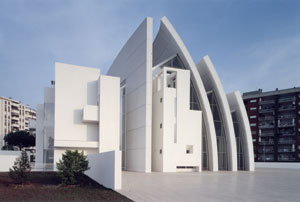Scientists are fighting smog by developing “smart” building materials that clean the air with a little help from the elements.
Using technology already available for self-cleaning windows and bathroom tiles, they hope to paint up cities with materials that dissolve and wash away pollutants when exposed to sun and rain. “We want to construct concrete walls that break down vehicle exhausts in road tunnels,” said Karin Pettersson, from Swedish construction giant Skanska. “It is also possible to make pavings that clean the air in cities.”

The project aims at developing catalytic cement and concrete products coated with titanium dioxide, a compound that can become highly reactive when exposed to UV light. UV rays hitting the titanium dioxide trigger a catalytic reaction that destroys the molecules of pollutants. The reaction also prevents bacteria and dirt from sticking to a surface, making them easily removed by a splash of water or rain.
In Rome, the Dives in Misericordia church (picture above), designed by Richard Meier, is made of self-cleaning concrete that helps keep the surface shiny white. In Japan, several buildings including the Marunouchi Building in Tokyo, are covered with photocatalytic tiles to reduce discoloring from pollution.
“Now we have to change and think of the product not just for architectural purposes, but also for environmental purposes,” said Francesco Galimberti, spokesman for Italcementi, maker of the concrete for the church in Rome.
However, some scientists caution it’s too soon to declare a titanium dioxide-fueled war on pollution. “Trying to clean up air pollution seems to me to be a stretch,” said Reynaldo Barreto, from Purdue University. “It doesn’t mean it can’t be done. But there’s an awful lot of air and not a whole lot of surface.”
Via CNN.
See also: Carbon-eating cement and Biopaver (via MetropolisMag)







